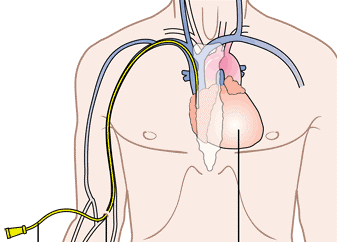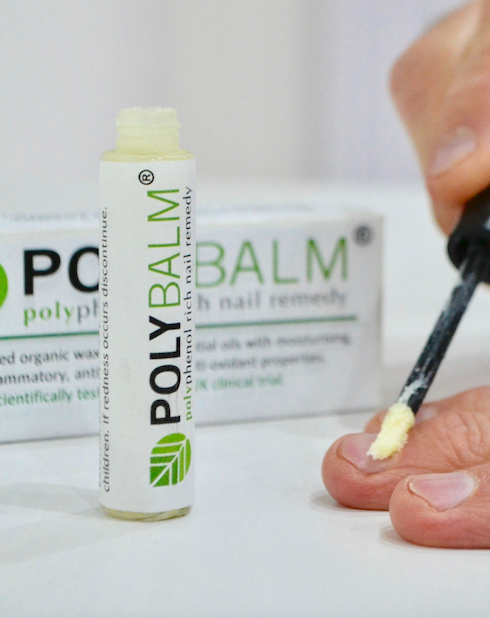|
|
||||||||||||||
|
PICC lines |
||||||||||||||
| Links: Tips to help symptoms: Nausea | Hair loss | Fatigue | Mouth care | Indigestion | Itching | Hot flushes | Pins & needles | Joint & muscle pains | Support drugs | Cold caps | Neulasta | Sperm storage | Egg storage | Common tests | Blood transfusion | Lifestyle guide | GP advice | | ||||||||||||||
 Traditionally
chemotherapy is administered into a vein, usually in the back of the hand. This
is uncomfortable and you may experience darkening of the veins in your hands and
arms as chemotherapy progresses. Towards the end of your chemotherapy course,
some veins may feel hard and 'cord-like'. In these veins the blood has clotted
(superficial thrombosis) which may take several months to resolve. As an
alternative to this it is often possible to insert a PICC line. This is kept in
throughout the chemotherapy. It is a long, thin, flexible tube known as a catheter. It is inserted
into one of the large veins of the arm in the front of the elbow. It is
then inserted into the vein until the tip rests in a large vein just above the
heart. Traditionally
chemotherapy is administered into a vein, usually in the back of the hand. This
is uncomfortable and you may experience darkening of the veins in your hands and
arms as chemotherapy progresses. Towards the end of your chemotherapy course,
some veins may feel hard and 'cord-like'. In these veins the blood has clotted
(superficial thrombosis) which may take several months to resolve. As an
alternative to this it is often possible to insert a PICC line. This is kept in
throughout the chemotherapy. It is a long, thin, flexible tube known as a catheter. It is inserted
into one of the large veins of the arm in the front of the elbow. It is
then inserted into the vein until the tip rests in a large vein just above the
heart.
Sometimes the tube has two or three lumens allowing different treatments to be given at the same time. At the end of the tube outside the body, each lumen has a special cap, to which a drip line or syringe can be attached. Sometimes there is a clamp to keep the tube closed when it is not in use. How are PICC lines inserted. PICC lines are inserted by a specially-trained nurse or doctor, in an outpatient department or on the ward. It will be put in using a local anaesthetic, so it is a relatively painless procedure.
If your veins are small, it may be difficult to put the PICC in. Sometimes it can be difficult to thread the PICC up the vein towards the heart. If this happens, it is possible to try again using a different vein. Sometimes the PICC seems to go in easily but the x-ray shows it is not in the right place. If this happens it will be taken out and replaced. Caring for your PICC When the line is not being used there is a slight risk that it may become blocked. To stop this happening a small amount of fluid is flushed into the line using a syringe. This is done regularly, usually once a week. The dressing will also need to be changed each week to reduce the risk of infection. As it is difficult to do this yourself with one hand, the nurses at the hospital may do it for you or arrange for a district nurse to visit you at home. A partner, relative or friend can also be taught to do this if possible It is important to be physically active during chemotherapy but exercising the arm or shoulder on the side with a pic line may be difficult. Certainly heavy weights should be avoided as well as swimming or racket sports. Brisk walking or gentle running is good and is unlikely to dislodge or damage the line. Possible complications Infection It is possible for an infection to develop inside or around the place where the line goes into the vein. If this area becomes red, swollen or oozes, or if you develop a temperature, you should tell your hospital doctor or nurse. You will be given antibiotics or, occasionally, the line may have to be removed.Blood clots It is possible for a blood clot (thrombosis) to form in your vein at the tip of the PICC. You may be given a tablet of warfarin (an anticoagulant) to take each day to help prevent this. If you do develop a blood clot, you will be given medicines to dissolve the clot and your line may have to be removed. Signs of a blood clot around the PICC include swelling, redness or tenderness in the arm, chest area or up into the neck (on the same side as the PICC). Air in the line. Air must not be allowed to get into your PICC line. The clamps should always be closed when the line is not in use. The line must not be left unclamped when the caps are not in place. Breaks It is important that the PICC line is not cut or split. Do not use scissors near the PICC. If it does get damaged you should contact your hospital immediately as it may need to be removed if it cannot be repaired while still in place. Removing the PICC line. When the PICC is no longer needed it will be taken out. A nurse will usually do this for you in an outpatient department. It will be gently pulled out. This is a painless procedure that takes only a few minutes. |
||||||||||||||
 A PICC line enables chemotherapy to be injected without having to use a new vein
each time. It can also be used to inject other drugs such as antibiotics and
take blood. (Chemotherapy is the use of drugs or chemicals to treat
A PICC line enables chemotherapy to be injected without having to use a new vein
each time. It can also be used to inject other drugs such as antibiotics and
take blood. (Chemotherapy is the use of drugs or chemicals to treat  First, the skin in the area where the PICC will be inserted is numbed, using
a special anaesthetic cream. When the skin is completely numb, a needle will be
inserted and then removed. While the needle is being removed, the PICC is
threaded through it into the large vein which leads to your heart. This should
not take long and is usually painless. The PICC will be held securely in place
by a transparent dressing. You will then have a chest x-ray to check that the
end of the tube is in the correct position.
First, the skin in the area where the PICC will be inserted is numbed, using
a special anaesthetic cream. When the skin is completely numb, a needle will be
inserted and then removed. While the needle is being removed, the PICC is
threaded through it into the large vein which leads to your heart. This should
not take long and is usually painless. The PICC will be held securely in place
by a transparent dressing. You will then have a chest x-ray to check that the
end of the tube is in the correct position.



